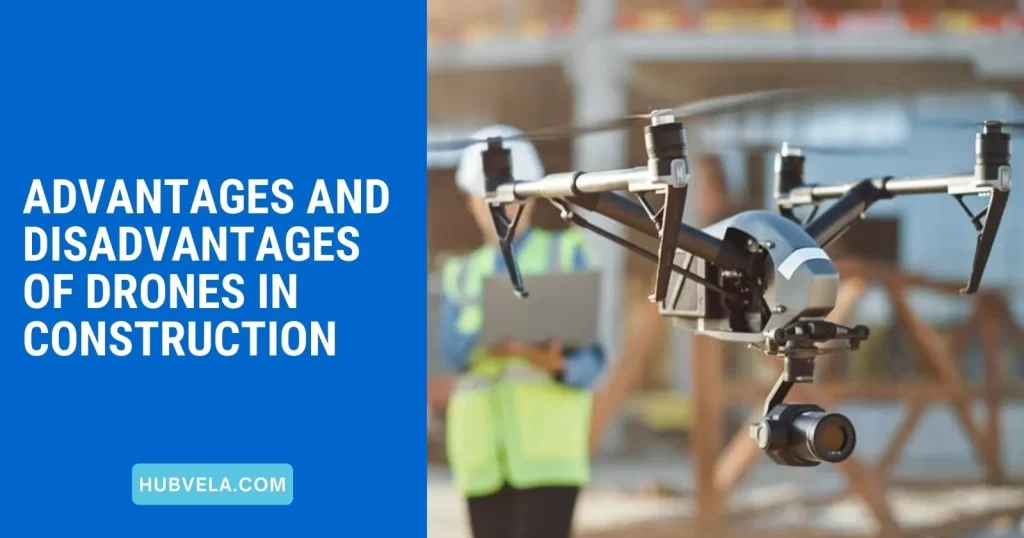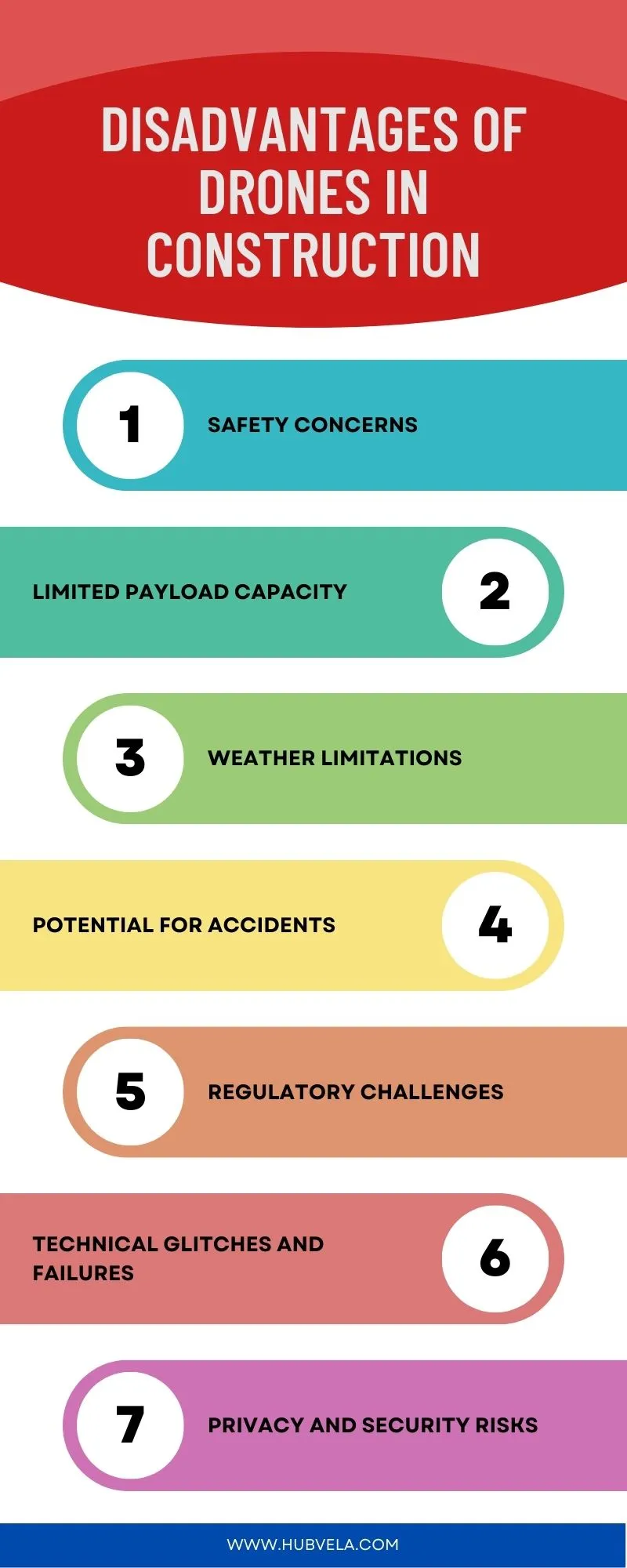Imagine standing at the edge of a vast construction site, watching as workers scurry around like ants, trying to ensure that every piece falls perfectly into place.
Now, picture a drone hovering above, effortlessly capturing every detail and providing a bird’s-eye view of the entire operation.
Drones, once confined to the realms of science fiction, have become a reality in the construction industry. However, like any new technology, they bring both pros and cons to the table.
So, strap in and prepare to explore the advantages and disadvantages of drones in construction.

--Advertisement--
Advantages of Drones in Construction
Drones offer several advantages in the construction industry, revolutionizing traditional practices. The benefits of using drones in construction include:

1. Improved Project Monitoring
Drones revolutionize project monitoring in construction, providing enhanced efficiency and accuracy.
The advantages of using drones for project monitoring include real-time tracking, allowing you to monitor progress and make informed decisions on the go.
Drones also enable remote site inspections, eliminating the need for physical presence and saving time and resources.
Additionally, drones provide cost savings by reducing the need for manual labor and improving overall project management.
2. Enhanced Safety Measures
By incorporating drones into project monitoring, construction teams can achieve improved efficiency and accuracy. Drones enable remote monitoring of construction sites, allowing for improved inspections and real-time data collection.
This reduces the need for workers to physically access hazardous areas, thereby enhancing safety measures on the job site. Drones also aid in compliance management by providing a comprehensive view of the site, ensuring that safety protocols are followed effectively.
3. Efficient Data Collection
To efficiently collect data in construction, drones offer a game-changing solution. With their ability to perform aerial photography and site inspection, drones provide accurate and real-time data for data analysis and project progress monitoring.
They can capture high-resolution images and videos, enabling construction professionals to assess the site remotely and make informed decisions. Drones also excel in obstacle detection, helping to identify potential hazards and ensure the safety of workers on the construction site.
4. Increased Productivity Levels
With their ability to streamline operations and enhance efficiency, drones revolutionize productivity in the construction industry. By automating various tasks, drones contribute to increased efficiency and significant time savings.
They can quickly collect data from construction sites, allowing for more accurate and timely analysis. Drones also aid in project management by providing real-time updates on progress and identifying potential issues.
Furthermore, they contribute to quality control by conducting inspections and identifying defects, ensuring construction projects meet the highest standards.
5. Cost-Effective Solutions
Drones in construction offer cost-effective solutions that significantly reduce expenses and optimize project budgets. With their cost-saving benefits and time-efficient solutions, drones revolutionize the construction industry.
They enable improved project planning by providing real-time aerial views and accurate measurements, eliminating the need for manual surveys.
Drones also enhance data analysis by capturing high-resolution images and videos, allowing project managers to make informed decisions.
6. Enhanced Accuracy and Precision
By leveraging their advanced capabilities, drones in construction enhance accuracy and precision, elevating the level of project planning and execution.
With improved surveying techniques, drones are able to capture highly accurate data that can be used for creating precise 3D models and maps.
Real-time monitoring allows construction professionals to track progress and identify potential issues promptly.
Drones also enable remote inspections, reducing the need for workers to physically access hazardous or hard-to-reach areas.
This faster progress tracking and reduced human error contribute to more efficient and precise construction processes.
7. Streamlined Workflow Processes
To streamline workflow processes in construction, drones offer a range of advantages that enhance efficiency and productivity. With their automation benefits, drones can save time by quickly and accurately completing tasks that would otherwise take hours or even days.
Drones also provide improved documentation by capturing detailed aerial footage and images, allowing for better project coordination and reducing the risk of errors caused by human oversight.
Disadvantages of Drones in Construction
Drones have become increasingly popular in the construction industry due to their ability to improve efficiency, reduce costs, and improve safety. However, there are also several disadvantages to using drones in construction.

1. Safety Concerns
One major disadvantage of using drones in construction is the potential safety concerns they pose. While drone regulations and safety guidelines exist, accidents can still happen.
Adequate training requirements must be in place to ensure operators are knowledgeable and skilled. Risk assessment should be conducted to identify potential hazards and mitigate them.
Additionally, emergency response plans should be established to address any unforeseen incidents promptly and effectively.
Safety remains a critical aspect that needs to be carefully managed when utilizing drones in construction.
2. Limited Payload Capacity
Using drones in construction comes with a notable disadvantage – their limited payload capacity. Payload limitations can hinder the use of drones for certain construction applications that require heavy equipment or materials to be transported.
Although technological advancements have increased the payload capacity of drones over the years, operational challenges still persist. In order to overcome this limitation, alternative solutions such as using multiple drones or employing other methods of transportation may need to be considered.
3. Weather Limitations
Weather limitations pose significant challenges for the use of drones in construction. Unfavorable weather conditions such as strong winds, rain, or fog can affect the drone’s ability to fly and operate safely. Flight restrictions may also be imposed during inclement weather, further limiting the drone’s operational capabilities.
Moreover, adverse weather can impact the accuracy of data collected by the drone, leading to potential errors in construction planning and decision-making. Ultimately, these weather limitations can result in project delays and hinder the overall efficiency of using drones in construction.
4. Potential for Accidents
With the potential for accidents, drones in construction present significant drawbacks that need to be addressed. While drones offer numerous benefits, such as increased efficiency and cost savings, their use also poses potential risks.
Accident prevention should be a top priority, requiring the implementation of comprehensive safety measures, risk assessments, and safety protocols. It’s crucial to prioritize the development and enforcement of proper safety guidelines to minimize the chances of accidents and ensure the safe operation of drones in construction settings.
5. Regulatory Challenges
Implementing regulations for the use of drones in construction presents several challenges that need to be addressed.
Regulatory compliance is a major concern, as construction companies must ensure that their drone operations adhere to all applicable rules and regulations.
Airspace restrictions pose another challenge, as drones may be limited in where they can fly.
Additionally, licensing requirements for drone operators can be complex and time-consuming.
Insurance implications and privacy considerations also need to be carefully considered to mitigate any potential risks.
6. Technical Glitches and Failures
One major drawback of using drones in construction is the potential for technical glitches and failures. Equipment malfunctions, software errors, communication failures, and system crashes can hinder the smooth operation of drones on construction sites.
These technical issues can lead to delays in data collection, loss of important information, and even accidents. It’s crucial for construction companies to have contingency plans in place to address and mitigate these technical challenges when using drones in their projects.
7. Privacy and Security Risks
Privacy and security risks pose significant disadvantages to the use of drones in construction. With their ability to capture high-resolution images and videos, drones can potentially invade the privacy of individuals in nearby areas.
Additionally, there are security risks associated with unauthorized access to drone footage and data, which can lead to legal implications and breaches of data protection regulations. It’s crucial for construction companies to address these concerns and implement appropriate measures to mitigate these risks.
Conclusion on Advantages and Disadvantages of Drones in Construction
In weighing the advantages and disadvantages of drones in construction, it becomes evident that their integration offers numerous benefits while presenting a few challenges.
Pros of using drones in construction include increased efficiency, improved safety, and reduced costs. Drones can quickly survey large areas, capture high-quality images and videos, and provide real-time data for analysis.
However, there are also cons to consider, such as privacy concerns, regulatory limitations, and the need for skilled operators.
Despite these challenges, the benefits of drones in construction outweigh the drawbacks.


